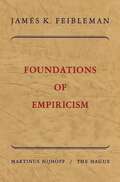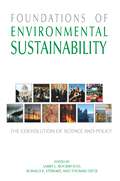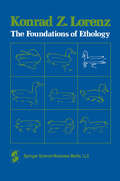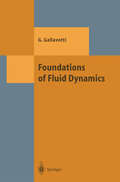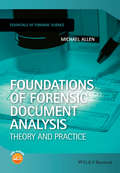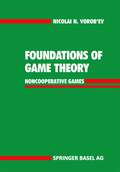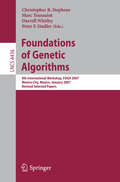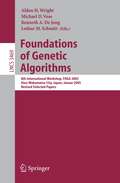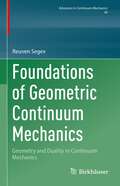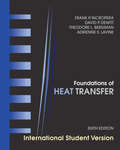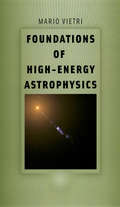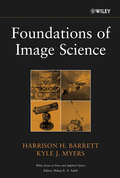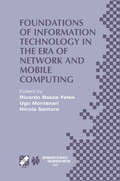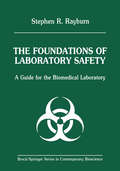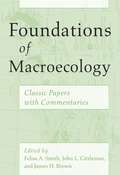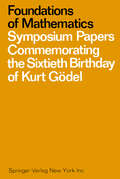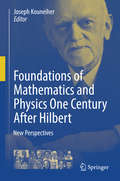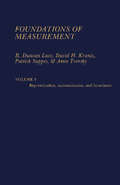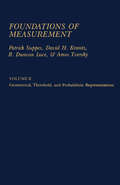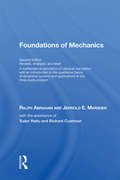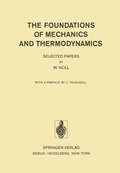- Table View
- List View
Foundations of empiricism
by James K. FeiblemanFor some centuries now the western world has endeavored to choose between rationalism and empiricism; or, when a choice was found impossible, somehow to reconcile them. But the particular brands of both which were taken for granted in confronting the problem were sUbjective: individual human reasoning stood for rationalism and private sense experience for empiricism. Since Plato it has been known that reasoning and feeling are often in conflict. No wonder that a standard for deciding between them or for harmonizing the two was found difficult to come by. Fortunately, due to the revival of realism, a way out presented itself, and we could now consider rationalism and empiricism on some kind of objective basis. In other words, rationalism is a theory about something outside us, and reasoning involves the utilization of a logic which in no wise depends upon our knowledge of it. Similarly; sense experience reveals the existence of data which can be reached through the senses but which in no way relies upon experience for its existence. Thus both reasoning and sensing bring us fragmentary news about an external world which contains not only logic and value but also the prospects for their reconciliation. The implicit philosophy of nominalism is self-liquidating. Where is the proposition which asserts or takes for granted the sole reality of actual physical particulars to get its reality? The meaning of it as a proposition has no place among the particulars.
Foundations of Environmental Sustainability: The Coevolution of Science and Policy
by Larry Rockwood Ronald Stewart Thomas DietzThis book reviews and analyzes the period (roughly from the 1950s to the present) when the "environment" became an issue as important as economic growth, or war and peace; to assess the current situation, and begin planning for the challenges that lie ahead. Most people are aware of both the environmental destruction taking place around the world and of the specter of climate change. The devastation of New Orleans by hurricane Katrina illustrates the potential for disaster when climate change is combined with the mismanaged environmental policy. How did we get to this point? What has been done and what can be done to avoid future environmental disasters? Thirty-two contributing chapter authors (among them, one of the principal drafters of the National Environmental Policy Act, Chief of the African Environment Division and the World Bank, Vice President of the Center for Conservation Innovation at the World Wildlife Fund, President of the Zoological Society of London, former President of the Ecological Society of America) use their unique, authoritative perspective to review the evolution of environmental science and policy in the past half century. Each author describes the evolution of environmental science and policy in the past half century and consider the challenges of the future. Although the authors of this book come from various fields, they have followed paths that have generally converged on the concept of sustainability. This book attempts to define what sustainability is, how we can achieve it, and what the prospects for sustainability in the future are.
The Foundations of Ethology
by K. LorenzThis book is a contribution to the history of ethology-not a definitive history, but the personal view of a major figure in that story. It is all the more welcome because such a grand theme as ethology calls for a range of perspectives. One reason is the overarching scope of the subject. Two great questions about life that constitute much of biology are "How does it work (structure and function)?" and "How did it get that way (evolu tion and ontogeny)?" Ethology addresses the antecedent of "it. " Of what are we trying to explain the mechanism and development? Surely behav ior, in all its wealth of detail, variation, causation, and control, is the main achievement of animal evolution, the essential consequence of animal structure and function, the raison d' etre of all the rest. Ethology thus spans between and overlaps with the ever-widening circles of ecol ogy over the eons and the ever-narrowing focus of physiology of the neurons. Another reason why the history of ethology needs perspectives is the recency of its acceptance. For such an obviously major aspect of animal biology, it is curious how short a time-less than three decades-has seen the excitement of an active field and a substantial fraternity of work ers, the addition of professors and courses to departments and curricula in biology (still far from universal}, and the normal complement of spe cial journals, symposia, and sessions at congresses.
Foundations of Fluid Dynamics (Theoretical and Mathematical Physics)
by Giovanni GallavottiThis monograph on fluid mechanics is not only a superb and unique textbook but also an impressive piece of research. It is the only textbook that fully covers turbulence, all the way from the works of Kolmogorov to modern dynamics.
Foundations of Forensic Document Analysis: Theory and Practice (Essentials of Forensic Science)
by Michael J. AllenForensic document examination is a long established specialty and its practitioners have regularly been shown to have acquired skills that enable them to assist the judicial process. This book, aimed primarily at students studying forensic science and document examination in particular, introduces all of the essential ideas that are to be found in the work of the forensic document examiner in a concise and straightforward way. Each examination type is described not only in terms of its procedural basis but also the science and reasoning that underpins it. The reader will be able to relate the different kinds of interpretation skills used by the document examiner to those used in other forensic disciplines. This book will be an invaluable text for all students taking courses in Forensic Science or related subjects. The book will also be a useful reference for researchers new to this field or practitioners looking for an accessible overview.The author will be adding new references that are relevant as they are published and some more worked examples from time to time. Please visit qdbook.blogspot.co.uk for more details.
Foundations of Forensic Document Analysis: Theory and Practice (Essentials of Forensic Science)
by Michael J. AllenForensic document examination is a long established specialty and its practitioners have regularly been shown to have acquired skills that enable them to assist the judicial process. This book, aimed primarily at students studying forensic science and document examination in particular, introduces all of the essential ideas that are to be found in the work of the forensic document examiner in a concise and straightforward way. Each examination type is described not only in terms of its procedural basis but also the science and reasoning that underpins it. The reader will be able to relate the different kinds of interpretation skills used by the document examiner to those used in other forensic disciplines. This book will be an invaluable text for all students taking courses in Forensic Science or related subjects. The book will also be a useful reference for researchers new to this field or practitioners looking for an accessible overview.The author will be adding new references that are relevant as they are published and some more worked examples from time to time. Please visit qdbook.blogspot.co.uk for more details.
Foundations of Game Theory: Noncooperative Games
by Nicolai N. Vorob'evThe English edition differs only slightly from the Russian original. The main struc tural difference is that all the material on the theory of finite noncooperative games has been collected in Chapter 2, with renumbering of the material of the remain ing chapters. New sections have been added in this chapter: devoted to general questions of equilibrium theory in nondegenerate games, subsections 3.9-3.17, by N.N. Vorob'ev, Jr.; and § 4, by A.G. Chernyakov; and § 5, by N.N. Vorob'ev, Jr., on the computational complexity of the process of finding equilibrium points in finite games. It should also be mentioned that subsections 3.12-3.14 in Chapter 1 were written by E.B. Yanovskaya especially for the Russian edition. The author regrets that the present edition does not reflect the important game-theoretical achievements presented in the splendid monographs by E. van Damme (on the refinement of equilibrium principles for finite games), as well as those by J.e. Harsanyi and R. Selten, and by W. Giith and B. Kalkofen (on equilibrium selection). When the Russian edition was being written, these direc tions in game theory had not yet attained their final form, which appeared only in quite recent monographs; the present author has had to resist the temptation of attempting to produce an elementary exposition of the new theories for the English edition; readers of this edition will find only brief mention of the new material.
Foundations of Genetic Algorithms: 9th International Workshop, FOGA 2007, Mexico City, Mexico, January 8-11, 2007, Revised Selected Papers (Lecture Notes in Computer Science #4436)
by Christopher R. Stephens Marc Toussaint Darrell Whitley Peter F. StadlerReaders will find here a fascinating text that is the thoroughly refereed post-proceedings of the 9th Workshop on the Foundations of Genetic Algorithms, FOGA 2007, held in Mexico City in January 2007. The 11 revised full papers presented were carefully reviewed and selected during two rounds of reviewing and improvement from 22 submissions. The papers address all current topics in the field of theoretical evolutionary computation and also depict the continuing growth in interactions with other fields such as mathematics, physics, and biology
Foundations of Genetic Algorithms: 8th International Workshop, FOGA 2005, Aizu-Wakamatsu City, Japan, January 5-9, 2005, Revised Selected Papers (Lecture Notes in Computer Science #3469)
by Alden H. Wright Michael D. Vose Kenneth A. De Jong Lothar M. SchmittThe8thWorkshopontheFoundationsofGeneticAlgorithms,FOGA-8,washeld at the University of Aizu in Aizu-Wakamatsu City, Japan, January 5–9, 2005. This series of workshops was initiated in 1990 to encourage further research on the theoretical aspects of genetic algorithms, and the workshops have been held biennially ever since. The papers presented at these workshops are revised, edited and published as volumes during the year following each workshop. This series of (now eight) volumes provides an outstanding source of reference for the theoretical work in this ?eld. At the same time this series of volumes provides a clear picture of how the theoretical research has grown and matured along with the ?eld to encompass many evolutionary computation paradigms including evolution strategies (ES), evolutionary programming (EP), and genetic programming (GP), as well as the continuing growthininteractionswith other ?elds suchas mathematics,physics, and biology. Atraditionoftheseworkshopsisorganizetheminsuchawayastoencourage lots of interaction and discussion by restricting the number of papers presented and the number of attendees, and by holding the workshop in a relaxed and informal setting. This year’s workshop was no exception. Thirty-two researchers met for 3 days to present and discuss 16 papers. The local organizer was Lothar Schmitt who, together with help and support from his university, provided the workshop facilities. Aftertheworkshopwasover,theauthorsweregiventheopportunitytorevise their papers based on the feedback they received from the other participants.
Foundations of Geometric Continuum Mechanics: Geometry and Duality in Continuum Mechanics (Advances in Mechanics and Mathematics #49)
by Reuven SegevThis monograph presents the geometric foundations of continuum mechanics. An emphasis is placed on increasing the generality and elegance of the theory by scrutinizing the relationship between the physical aspects and the mathematical notions used in its formulation. The theory of uniform fluxes in affine spaces is covered first, followed by the smooth theory on differentiable manifolds, and ends with the non-smooth global theory. Because continuum mechanics provides the theoretical foundations for disciplines like fluid dynamics and stress analysis, the author’s extension of the theory will enable researchers to better describe the mechanics of modern materials and biological tissues. The global approach to continuum mechanics also enables the formulation and solutions of practical optimization problems.Foundations of Geometric Continuum Mechanics will be an invaluable resource for researchers in the area, particularly mathematicians, physicists, and engineers interested in the foundational notions of continuum mechanics.
Foundations of Heat Transfer
by Frank P. Incropera David P. DeWitt Theodore L. Bergman Adrienne S. LavineCompletely updated, the sixth edition provides engineers with an in-depth look at the key concepts in the field. It incorporates new discussions on emerging areas of heat transfer, discussing technologies that are related to nanotechnology, biomedical engineering and alternative energy. The example problems are also updated to better show how to apply the material. And as engineers follow the rigorous and systematic problem-solving methodology, they’ll gain an appreciation for the richness and beauty of the discipline.
Foundations of High-Energy Astrophysics (Theoretical Astrophysics)
by Mario VietriWritten by one of today’s most highly respected astrophysicists, Foundations of High-Energy Astrophysics is an introduction to the mathematical and physical techniques used in the study of high-energy astrophysics. Here, Mario Vietri approaches the basics of high-energy astrophysics with an emphasis on underlying physical processes as opposed to a more mathematical approach. Alongside more traditional topics, Vietri presents new subjects increasingly considered crucial to understanding high-energy astrophysical sources, including the electrodynamics of cosmic sources, new developments in the theory of standard accretion disks, and the physics of coronae, thick disks, and accretion onto magnetized objects. The most thorough and engaging survey of high-energy astrophysics available today, Foundations of High-Energy Astrophysics introduces the main physical processes relevant to the field in a rigorous yet accessible way, while paying careful attention to observational issues. Vietri’s book will quickly become a classic text for students and active researchers in astronomy and astrophysics. Those in adjoining fields will also find it a valuable addition to their personal libraries.
Foundations of High-Energy Astrophysics (Theoretical Astrophysics)
by Mario VietriWritten by one of today’s most highly respected astrophysicists, Foundations of High-Energy Astrophysics is an introduction to the mathematical and physical techniques used in the study of high-energy astrophysics. Here, Mario Vietri approaches the basics of high-energy astrophysics with an emphasis on underlying physical processes as opposed to a more mathematical approach. Alongside more traditional topics, Vietri presents new subjects increasingly considered crucial to understanding high-energy astrophysical sources, including the electrodynamics of cosmic sources, new developments in the theory of standard accretion disks, and the physics of coronae, thick disks, and accretion onto magnetized objects. The most thorough and engaging survey of high-energy astrophysics available today, Foundations of High-Energy Astrophysics introduces the main physical processes relevant to the field in a rigorous yet accessible way, while paying careful attention to observational issues. Vietri’s book will quickly become a classic text for students and active researchers in astronomy and astrophysics. Those in adjoining fields will also find it a valuable addition to their personal libraries.
Foundations of Image Science (Wiley Series in Pure and Applied Optics #44)
by Harrison H. Barrett Kyle J. MyersWinner of the 2006 Joseph W. Goodman Book Writing Award! A comprehensive treatment of the principles, mathematics, and statistics of image science In today’s visually oriented society, images play an important role in conveying messages. From seismic imaging to satellite images to medical images, our modern society would be lost without images to enhance our understanding of our health, our culture, and our world. Foundations of Image Science presents a comprehensive treatment of the principles, mathematics, and statistics needed to understand and evaluate imaging systems. The book is the first to provide a thorough treatment of the continuous-to-discrete, or CD, model of digital imaging. Foundations of Image Science emphasizes the need for meaningful, objective assessment of image quality and presents the necessary tools for this purpose. Approaching the subject within a well-defined theoretical and physical context, this landmark text presents the mathematical underpinnings of image science at a level that is accessible to graduate students and practitioners working with imaging systems, as well as well-motivated undergraduate students. Destined to become a standard text in the field, Foundations of Image Science covers: Mathematical Foundations: Examines the essential mathematical foundations of image science Image Formation–Models and Mechanisms: Presents a comprehensive and unified treatment of the mathematical and statistical principles of imaging, with an emphasis on digital imaging systems and the use of SVD methods Image Quality: Provides a systematic exposition of the methodology for objective or task-based assessment of image quality Applications: Presents detailed case studies of specific direct and indirect imaging systems and provides examples of how to apply the various mathematical tools covered in the book Appendices: Covers the prerequisite material necessary for understanding the material in the main text, including matrix algebra, complex variables, and the basics of probability theory
Foundations of Information Technology in the Era of Network and Mobile Computing: IFIP 17th World Computer Congress — TC1 Stream / 2nd IFIP International Conference on Theoretical Computer Science (TCS 2002) August 25–30, 2002, Montréal, Québec, Canada (IFIP Advances in Information and Communication Technology #96)
by Ricardo Baeza-Yates Ugo Montanari Nicola SantoroFoundations of Information Technology in the Era of Network and Mobile Computing is presented in two distinct but interrelated tracks: -Algorithms, Complexity and Models of Computation; -Logic, Semantics, Specification and Verification.This volume contains 45 original and significant contributions addressing these foundational questions, as well as 4 papers by outstanding invited speakers. These papers were presented at the 2nd IFIP International Conference on Theoretical Computer Science (TCS 2002), which was held in conjunction with the 17th World Computer Congress, sponsored by the International Federation for Information Processing (IFIP), and which convened in Montréal, Québec, Canada in August 2002.
The Foundations of Laboratory Safety: A Guide for the Biomedical Laboratory (Brock Springer Series in Contemporary Bioscience)
by Stephen R. RayburnSafety is a word that has many connotations, of risk ofa possible accident that is acceptable conjuring up different meanings to different to one person· may not be acceptable to an people. What is safety? A scientist views safety other. This may be one reason why skydiving as a consideration in the design of an exper and mountain climbing are sports that are not iment. A manufacturing plant engineer looks as popular as are, say, boating or skiing. on safety as one of the necessary factors in But even activities that have high levels of developing a manufacturing process. A legis potential risk can be engaged in safely. How lator is likely to see safety as an important part can we minimize risks so that they decrease of an environmental law. A governmental ad to acceptable levels? We can do this by iden ministrator may consider various safety issues tifying sources of hazards and by assessing the when reviewing the environmental conse risks of accidents inherent to these hazards. quences of a proposed project. An attorney Most hazards that are faced in the laboratory may base a negligence suit on safety defects.
Foundations of Macroecology: Classic Papers with Commentaries
by Felisa A. Smith John L. Gittleman James H. BrownMacroecology is an approach to science that emphasizes the description and explanation of patterns and processes at large spatial and temporal scales. Some scientists liken it to seeing the forest through the trees, giving the proverbial phrase an ecological twist. The term itself was first introduced to the modern literature by James H. Brown and Brian A. Maurer in a 1989 paper, and it is Brown’s classic 1995 study, Macroecology, that is credited with inspiring the broad-scale subfield of ecology. But as with all subfields, many modern-day elements of macroecology are implicit in earlier works dating back decades, even centuries. Foundations of Macroecology charts the evolutionary trajectory of these concepts—from the species-area relationship and the latitudinal gradient of species richness to the relationship between body size and metabolic rate—through forty-six landmark papers originally published between 1920 and 1998. Divided into two parts—“Macroecology before Macroecology” and “Dimensions of Macroecology”—the collection also takes the long view, with each paper accompanied by an original commentary from a contemporary expert in the field that places it in a broader context and explains its foundational role. Providing a solid, coherent assessment of the history, current state, and potential future of the field, Foundations of Macroecology will be an essential text for students and teachers of ecology alike.
Foundations of Macroecology: Classic Papers with Commentaries
by Felisa A. Smith John L. Gittleman James H. BrownMacroecology is an approach to science that emphasizes the description and explanation of patterns and processes at large spatial and temporal scales. Some scientists liken it to seeing the forest through the trees, giving the proverbial phrase an ecological twist. The term itself was first introduced to the modern literature by James H. Brown and Brian A. Maurer in a 1989 paper, and it is Brown’s classic 1995 study, Macroecology, that is credited with inspiring the broad-scale subfield of ecology. But as with all subfields, many modern-day elements of macroecology are implicit in earlier works dating back decades, even centuries. Foundations of Macroecology charts the evolutionary trajectory of these concepts—from the species-area relationship and the latitudinal gradient of species richness to the relationship between body size and metabolic rate—through forty-six landmark papers originally published between 1920 and 1998. Divided into two parts—“Macroecology before Macroecology” and “Dimensions of Macroecology”—the collection also takes the long view, with each paper accompanied by an original commentary from a contemporary expert in the field that places it in a broader context and explains its foundational role. Providing a solid, coherent assessment of the history, current state, and potential future of the field, Foundations of Macroecology will be an essential text for students and teachers of ecology alike.
Foundations of Macroecology: Classic Papers with Commentaries
by Felisa A. Smith John L. Gittleman James H. BrownMacroecology is an approach to science that emphasizes the description and explanation of patterns and processes at large spatial and temporal scales. Some scientists liken it to seeing the forest through the trees, giving the proverbial phrase an ecological twist. The term itself was first introduced to the modern literature by James H. Brown and Brian A. Maurer in a 1989 paper, and it is Brown’s classic 1995 study, Macroecology, that is credited with inspiring the broad-scale subfield of ecology. But as with all subfields, many modern-day elements of macroecology are implicit in earlier works dating back decades, even centuries. Foundations of Macroecology charts the evolutionary trajectory of these concepts—from the species-area relationship and the latitudinal gradient of species richness to the relationship between body size and metabolic rate—through forty-six landmark papers originally published between 1920 and 1998. Divided into two parts—“Macroecology before Macroecology” and “Dimensions of Macroecology”—the collection also takes the long view, with each paper accompanied by an original commentary from a contemporary expert in the field that places it in a broader context and explains its foundational role. Providing a solid, coherent assessment of the history, current state, and potential future of the field, Foundations of Macroecology will be an essential text for students and teachers of ecology alike.
Foundations of Mathematics: Symposium Papers Commemorating the Sixtieth Birthday of Kurt Gödel
by Jack John Bulloff Thomas Campell Holyoke S. W. HahnDr. KURT GODEL'S sixtieth birthday (April 28, 1966) and the thirty fifth anniversary of the publication of his theorems on undecidability were celebrated during the 75th Anniversary Meeting of the Ohio Ac ademy of Science at The Ohio State University, Columbus, on April 22, 1966. The celebration took the form of a Festschrift Symposium on a theme supported by the late Director of The Institute for Advanced Study at Princeton, New Jersey, Dr. J. ROBERT OPPENHEIMER: "Logic, and Its Relations to Mathematics, Natural Science, and Philosophy." The symposium also celebrated the founding of Section L (Mathematical Sciences) of the Ohio Academy of Science. Salutations to Dr. GODEL were followed by the reading of papers by S. F. BARKER, H. B. CURRY, H. RUBIN, G. E. SACKS, and G. TAKEUTI, and by the announcement of in-absentia papers contributed in honor of Dr. GODEL by A. LEVY, B. MELTZER, R. M. SOLOVAY, and E. WETTE. A short discussion of "The II Beyond Godel's I" concluded the session.
Foundations of Mathematics and Physics One Century After Hilbert: New Perspectives
by Joseph KouneiherThis book explores the rich and deep interplay between mathematics and physics one century after David Hilbert’s works from 1891 to 1933, published by Springer in six volumes. The most prominent scientists in various domains of these disciplines contribute to this volume providing insight to their works, and analyzing the impact of the breakthrough and the perspectives of their own contributions. The result is a broad journey through the most recent developments in mathematical physics, such as string theory, quantum gravity, noncommutative geometry, twistor theory, Gauge and Quantum fields theories, just to mention a few. The reader, accompanied on this journey by some of the fathers of these theories, explores some far reaching interfaces where mathematics and theoretical physics interact profoundly and gets a broad and deep understanding of subjects which are at the core of recent developments in mathematical physics. The journey is not confined to the present state of the art, but sheds light on future developments of the field, highlighting a list of open problems. Graduate students and researchers working in physics, mathematics and mathematical physics will find this journey extremely fascinating. All those who want to benefit from a comprehensive description of all the latest advances in mathematics and mathematical physics, will find this book very useful too.
Foundations of Measurement: Volume 3
by R Duncan LuceFrom the Foreword is infinite in multitude; and I mean by the sand not only that which exists about Syracuse and the rest of Sicily but also that which is found in every region whether inhabited or unhabited. Again there are some who, without regarding it as infinite, yet think that no number has been named which is great enough to exceed its multitude. And it is clear that they who hold this view, if they imagined a mass made up of sand in other respects as large as the mass of the earth, including in it all the seas and the hollows of the earth filled up to a height equal to that of the highest mountains, would be many times further still from recognizing that any number could be expressed which exceeded the multitude of the sand so taken. But I will try to show you by means of geometrical proofs, which you will be able to follow, that, of the numbers named by me and given in the work which I sent to Zeuxippus, some exceed not only the number of the mass of sand equal in magnitude to the earth filled up in the way described, but also that of a mass equal in magnitude to the universe.:See Table of Contents and MAQ.
Foundations of Measurement: Volume 2
by Patrick SuppesFoundations of Measurement offers the most coherently organized treatment of the topics and issues central to measurement. Much of the research involved has been scattered over several decades and a multitude of journals--available in many instances only to specialties. With the publication of Volumes two and three of this important work, Foundations of Measurement is the most comprehensive presentation in the area of measurement.
Foundations Of Mechanics
by Ralph AbrahamFoundations of Mechanics is a mathematical exposition of classical mechanics with an introduction to the qualitative theory of dynamical systems and applications to the two-body problem and three-body problem.
The Foundations of Mechanics and Thermodynamics: Selected Papers
by W. NollGerman scholars, against odds now not only forgotten but also hard to imagine, were striving to revivify the life of the mind which the mental and physical barbarity preached and practised by the -isms and -acies of 1933-1946 had all but eradicated. Thinking that among the disciples of these elders, restorers rather than progressives, I might find a student or two who would wish to master new mathematics but grasp it and use it with the wholeness of earlier times, in 1952 I wrote to Mr. HAMEL, one of the few then remaining mathematicians from the classical mould, to ask him to name some young men fit to study for the doc torate in The Graduate Institute for Applied Mathematics at Indiana University, flourishing at that time though soon to be destroyed by the jealous ambition of the local, stereotyped pure. Having just retired from the Technische Universitat in Charlottenburg, he passed my inquiry on to Mr. SZABO, in whose institute there NOLL was then an assistant. Although Mr.
